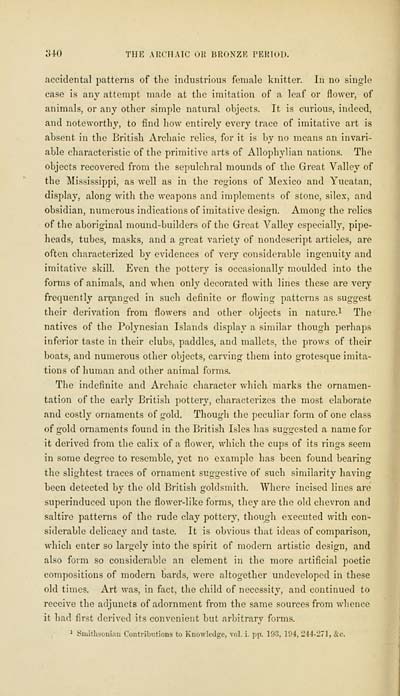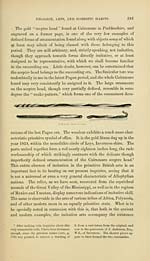Download files
Complete book:
Individual page:
Thumbnail gallery: Grid view | List view

o40 THE ARCHAIC OR BRONZE PERIOD.
accidental patterns of the industrious female knitter. In no single
case is any attempt made at the imitation of a leaf or flower, of
animals, or any other simple natural objects. It is curious, indeed,
and noteworthy, to find how entirely every trace of imitative art is
absent in the British Archaic relics, for it is by no means an invari-
able characteristic of the primitive arts of Allophylian nations. The
objects recovered from the sepulchral mounds of the Great Valley of
the Mississippi, as well as in the regions of Mexico and Yucatan,
display, along with the weapons and implements of stone, silex, and
obsidian, numerous indications of imitative design. Among the relics
of the aboriginal mound-builders of the Great Valley especially, pipe-
heads, tubes, masks, and a great variet}' of nondescript articles, are
often characterized by evidences of very considerable ingenuity and
imitative skill. Even the pottery is occasionally moulded into the
forms of animals, and when only decorated with lines these are very
frequently arranged in such definite or flowing patterns as suggest
their derivation from flowers and other objects in nature.^ The
natives of the Polynesian Islands display a similar though perhaps
inferior taste in their clubs, paddles, and mallets, the prows of their
boats, and numerous other objects, carving them into grotesque imita-
tions of human and other animal forms.
The indefinite and Archaic character which marks the ornamen-
tation of the early British pottery, characterizes the most elaborate
and costly ornaments of gold. Though the peculiar form of one class
of gold ornaments found in the British Isles has suggested a name for
it derived from the calix of a flower, which the cups of its rings seem
in some degree to resemble, yet no example has been found bearing
the slightest traces of ornament suggestive of such similarity having
been detected by the old British goldsmith. Whei'o incised lines are
superinduced upon the flower-like forms, they are the old chevron and
saltire patterns of the rude clay pottery, though executed with con-
siderable delicacy and taste. It is obvious that ideas of comparison,
which enter so largely into the spirit of modern artistic design, and
also form so considerable an element in the more artificial poetic
compositions of modern bards, were altogether undeveloped in these
old times. Art Avas, in fact, the child of necessity, and continued to
receive the adjuncts of adornment from the same sources from whence
it had first derived its convenient but arbitrary forms.
' Smithsonifin Contributions to Knowledge, vol. i. pp. 193, 194, 244-271, &c.
accidental patterns of the industrious female knitter. In no single
case is any attempt made at the imitation of a leaf or flower, of
animals, or any other simple natural objects. It is curious, indeed,
and noteworthy, to find how entirely every trace of imitative art is
absent in the British Archaic relics, for it is by no means an invari-
able characteristic of the primitive arts of Allophylian nations. The
objects recovered from the sepulchral mounds of the Great Valley of
the Mississippi, as well as in the regions of Mexico and Yucatan,
display, along with the weapons and implements of stone, silex, and
obsidian, numerous indications of imitative design. Among the relics
of the aboriginal mound-builders of the Great Valley especially, pipe-
heads, tubes, masks, and a great variet}' of nondescript articles, are
often characterized by evidences of very considerable ingenuity and
imitative skill. Even the pottery is occasionally moulded into the
forms of animals, and when only decorated with lines these are very
frequently arranged in such definite or flowing patterns as suggest
their derivation from flowers and other objects in nature.^ The
natives of the Polynesian Islands display a similar though perhaps
inferior taste in their clubs, paddles, and mallets, the prows of their
boats, and numerous other objects, carving them into grotesque imita-
tions of human and other animal forms.
The indefinite and Archaic character which marks the ornamen-
tation of the early British pottery, characterizes the most elaborate
and costly ornaments of gold. Though the peculiar form of one class
of gold ornaments found in the British Isles has suggested a name for
it derived from the calix of a flower, which the cups of its rings seem
in some degree to resemble, yet no example has been found bearing
the slightest traces of ornament suggestive of such similarity having
been detected by the old British goldsmith. Whei'o incised lines are
superinduced upon the flower-like forms, they are the old chevron and
saltire patterns of the rude clay pottery, though executed with con-
siderable delicacy and taste. It is obvious that ideas of comparison,
which enter so largely into the spirit of modern artistic design, and
also form so considerable an element in the more artificial poetic
compositions of modern bards, were altogether undeveloped in these
old times. Art Avas, in fact, the child of necessity, and continued to
receive the adjuncts of adornment from the same sources from whence
it had first derived its convenient but arbitrary forms.
' Smithsonifin Contributions to Knowledge, vol. i. pp. 193, 194, 244-271, &c.
Set display mode to: Large image | Transcription
Images and transcriptions on this page, including medium image downloads, may be used under the Creative Commons Attribution 4.0 International Licence unless otherwise stated. ![]()
| Early Gaelic Book Collections > J. F. Campbell Collection > Archaeology and prehistoric annals of Scotland > (382) |
|---|
| Permanent URL | https://digital.nls.uk/78375878 |
|---|
| Description | Volumes from a collection of 610 books rich in Highland folklore, Ossianic literature and other Celtic subjects. Many of the books annotated by John Francis Campbell of Islay, who assembled the collection. |
|---|
| Description | Selected items from five 'Special and Named Printed Collections'. Includes books in Gaelic and other Celtic languages, works about the Gaels, their languages, literature, culture and history. |
|---|

